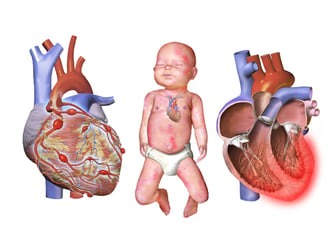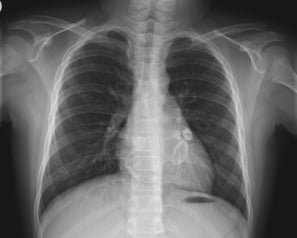Mucocutaneous Lymph Node Syndrome (Kawasaki Disease)
Mucocutaneous lymph node syndrome, commonly known as Kawasaki disease, is a rare but serious illness that primarily affects children under the age of five. This inflammatory condition targets blood vessels throughout the body, leading to complications that can affect the heart if left untreated. While its exact cause remains unknown, early diagnosis and treatment are crucial in preventing long-term damage.
GENETICVASCULARCARDIOLOGY
Rishwin A R
2/11/20253 min read


Image credit: Kawasaki Disease. Source: Wikipedia. Licensed under CC BY-SA 3.0. Link to image
Causes and Risk Factors
The precise cause of Kawasaki disease is still a mystery, but research suggests that a combination of genetic and environmental factors may be responsible. Some potential triggers include:
Infections: Viral or bacterial infections may play a role in triggering the immune response seen in Kawasaki disease.
Genetics: Children of Asian descent, particularly Japanese and Korean, have a higher incidence of the disease, suggesting a genetic predisposition.
Immune system dysfunction: Some researchers believe an abnormal immune response to common pathogens may contribute to the condition.
Symptoms of Kawasaki Disease
Kawasaki disease progresses in three distinct phases, each with characteristic symptoms:
1. Acute Phase (Days 1-11)
Persistent high fever (lasting more than five days)
Red, bloodshot eyes (conjunctivitis) without pus
Rash on the trunk and groin area
Swollen, red lips and a "strawberry tongue"
Swollen hands and feet, sometimes with peeling skin
Enlarged lymph nodes, especially in the neck
2. Subacute Phase (Days 12-21)
Peeling skin on the fingers and toes
Joint pain and irritability
Abdominal pain, vomiting, or diarrhea
Increased risk of coronary artery complications
3. Convalescent Phase (Days 22 and Beyond)
Symptoms gradually improve, but lingering fatigue and irritability may persist
Coronary artery abnormalities may develop if the disease was untreated
Diagnosis
There is no specific test for Kawasaki disease, so doctors rely on clinical criteria and laboratory tests. Diagnosis is made when a child has a fever for at least five days along with at least four of the main symptoms. Additional tests may include:
Echocardiogram (to check for heart complications)
Blood tests (to assess inflammation markers)
Urine tests (to rule out infections)
Electrocardiogram (ECG) (to monitor heart function)
Treatment
Early treatment is crucial to prevent heart complications. The standard treatment includes:
1. Intravenous Immunoglobulin (IVIG)
High doses of IVIG significantly reduce the risk of coronary artery damage when given early.
2. Aspirin Therapy
Unusual for children, but in Kawasaki disease, aspirin is used to reduce inflammation and prevent blood clot formation.
Dosage may be adjusted as the disease progresses.
3. Corticosteroids (In Severe Cases)
Sometimes used when IVIG is ineffective.
Complications
If untreated, Kawasaki disease can lead to severe complications, primarily affecting the heart. These include:
Coronary artery aneurysms
Myocarditis (inflammation of the heart muscle)
Heart valve problems
Increased risk of heart attacks later in life
Prognosis and Long-Term Outlook
With timely treatment, most children recover fully without long-term issues. However, those who develop heart complications require lifelong monitoring. Regular cardiac check-ups and lifestyle modifications may be necessary for some patients.
Prevention
Currently, there is no known way to prevent Kawasaki disease. However, early detection and treatment are key to minimizing complications. Parents should seek medical attention if their child has a persistent fever and any of the characteristic symptoms.
Frequently Asked Questions (FAQs)
1. Is Kawasaki disease contagious?
No, Kawasaki disease is not contagious. It does not spread from person to person, but it may be triggered by an immune response to infections.
2. Can adults get Kawasaki disease?
While rare, adults can develop Kawasaki disease, but it is overwhelmingly a childhood illness.
3. How is Kawasaki disease different from measles or scarlet fever?
While they share some symptoms like rash and fever, Kawasaki disease has unique features such as prolonged fever, swollen hands/feet, and heart complications that differentiate it from other illnesses.
4. What happens if Kawasaki disease goes untreated?
Untreated Kawasaki disease can lead to serious heart complications, including aneurysms and increased risk of heart attacks later in life.
5. Can Kawasaki disease recur?
Yes, though rare, Kawasaki disease can recur, especially in children with underlying immune system conditions.


An X-ray revealing aneurysmal enlargement of the coronary arteries, a serious complication associated with Kawasaki syndrome.
Syndromes.xyz
Explore medical syndromes and their details here.
For Educational purposes only
The information on this site is not in any way, replacement for professional advice. Always consult your physician regarding personal queries
Connect
Support
syndromesxyz@gmail.com
© 2024. All rights reserved.
